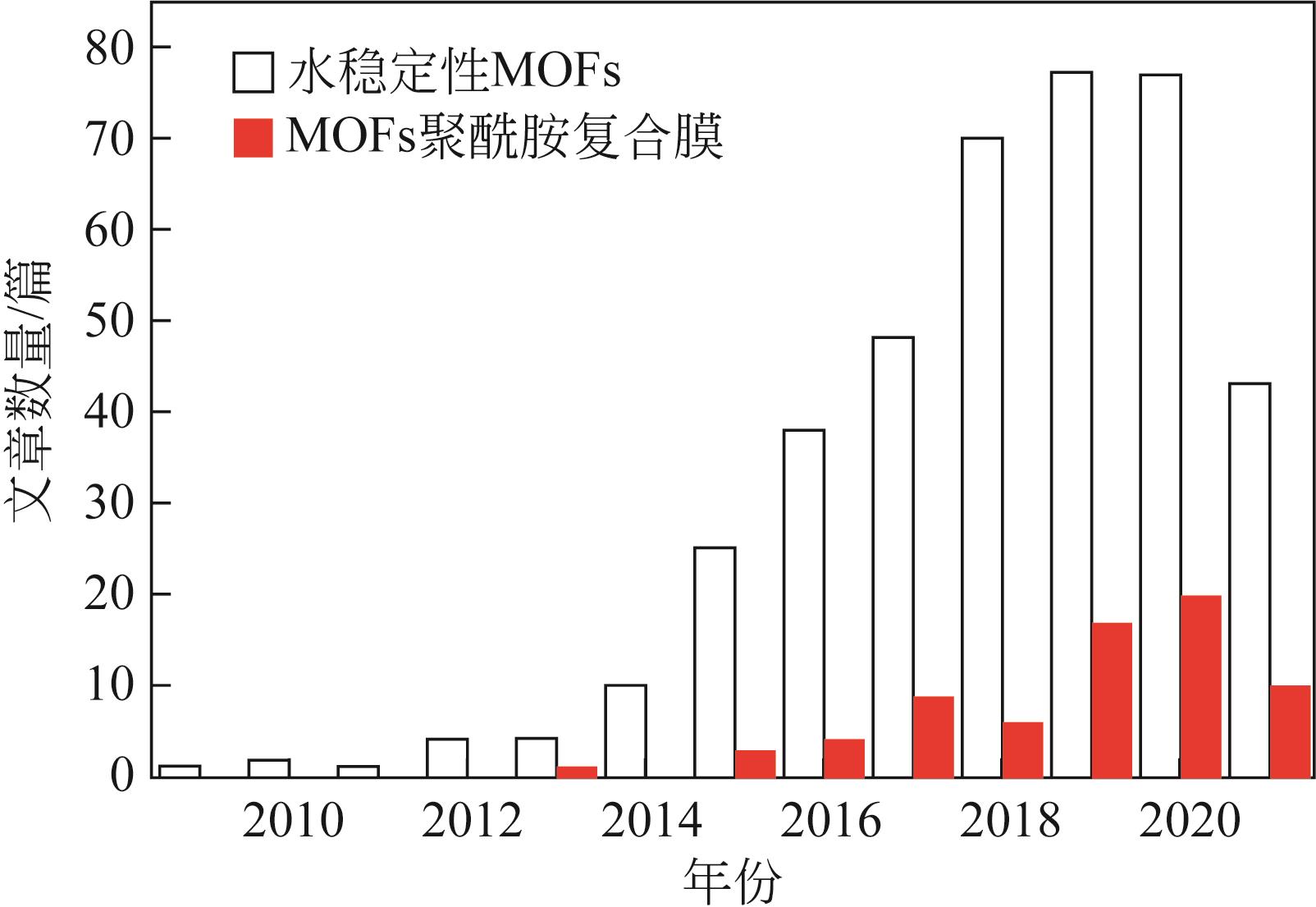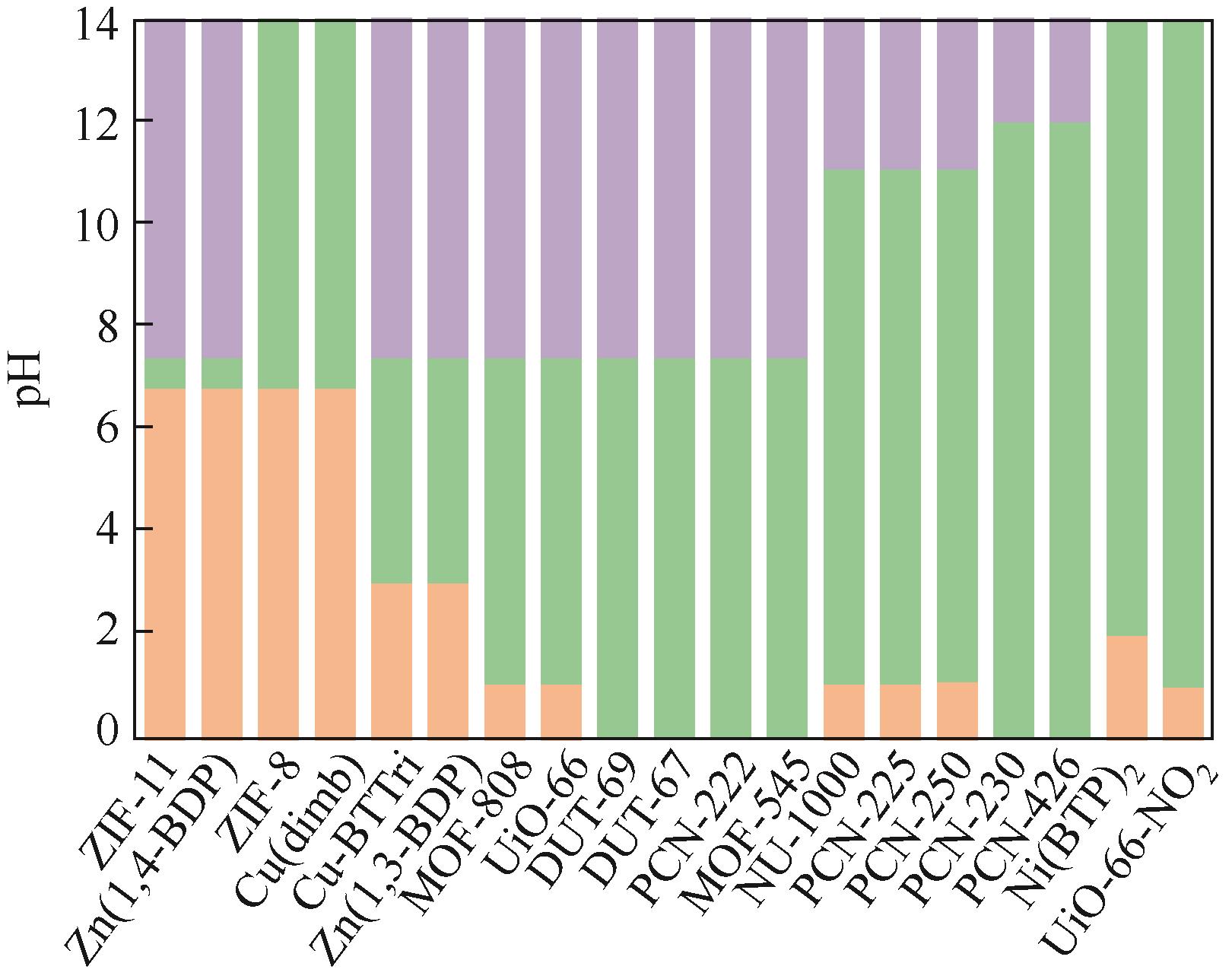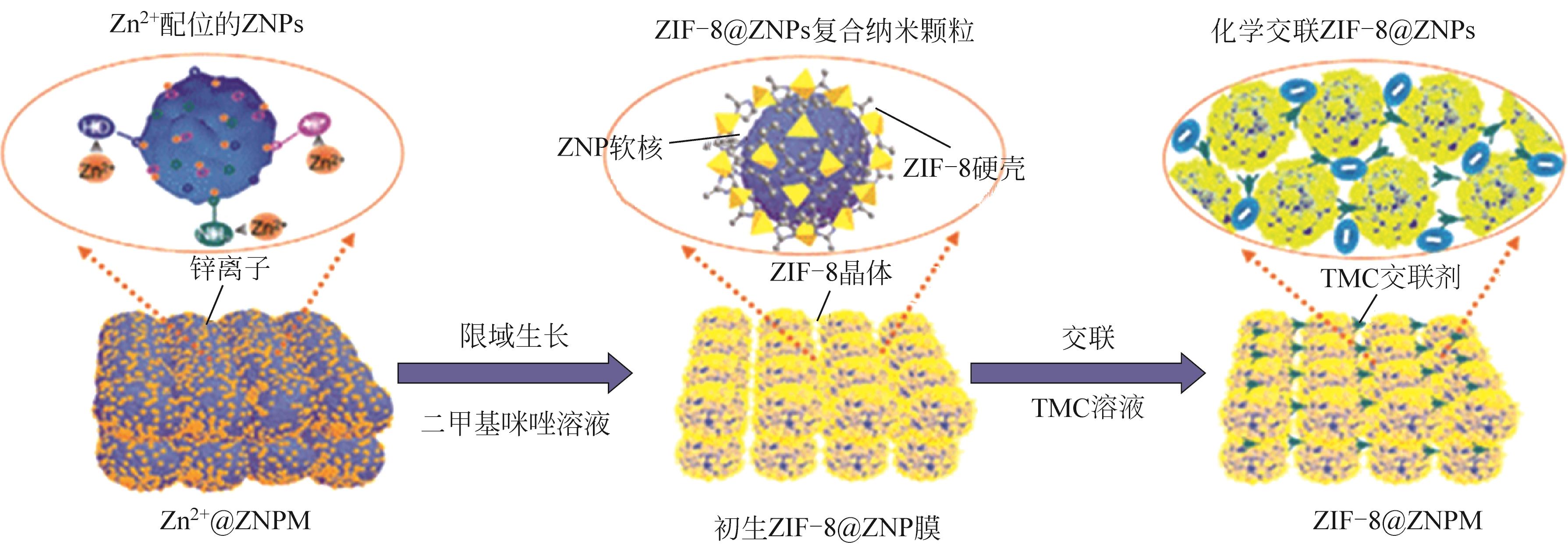Chemical Industry and Engineering Progress ›› 2022, Vol. 41 ›› Issue (8): 4314-4326.DOI: 10.16085/j.issn.1000-6613.2021-1946
• Materials science and technology • Previous Articles Next Articles
Research progress of metal organic framework/polyamide thin film nanocomposite membrane
ZHU Xiao1,2( ), ZHU Junyong1,2(
), ZHU Junyong1,2( ), ZHANG Yatao1,2(
), ZHANG Yatao1,2( )
)
- 1.School of Chemical Engineering, Zhengzhou University, Zhengzhou 450001, Henan, China
2.Zhengzhou Key Laboratory of Advanced Separation Technology, Zhengzhou 450001, Henan, China
-
Received:2021-09-10Revised:2021-11-19Online:2022-08-22Published:2022-08-25 -
Contact:ZHU Junyong,ZHANG Yatao
金属有机骨架/聚酰胺薄层纳米复合膜的研究进展
- 1.郑州大学化工学院,河南 郑州 450001
2.郑州市先进分离技术重点实验室,河南 郑州 450001
-
通讯作者:朱军勇,张亚涛 -
作者简介:朱晓(1997—),男,硕士研究生,研究方向为水处理纳滤膜分离。E-mail:15237156940@163.com 。 -
基金资助:国家自然科学基金(22108257)
CLC Number:
Cite this article
ZHU Xiao, ZHU Junyong, ZHANG Yatao. Research progress of metal organic framework/polyamide thin film nanocomposite membrane[J]. Chemical Industry and Engineering Progress, 2022, 41(8): 4314-4326.
朱晓, 朱军勇, 张亚涛. 金属有机骨架/聚酰胺薄层纳米复合膜的研究进展[J]. 化工进展, 2022, 41(8): 4314-4326.
share this article
Add to citation manager EndNote|Ris|BibTeX
URL: https://hgjz.cip.com.cn/EN/10.16085/j.issn.1000-6613.2021-1946
| 1 | SHANNON M A, BOHN P W, ELIMELECH M, et al. Science and technology for water purification in the coming decades[J]. Nature, 2008, 452(7185): 301-310. |
| 2 | JI C H, ZHAI Z, JIANG C, et al. Recent advances in high-performance TFC membranes: a review of the functional interlayers[J]. Desalination, 2021, 500: 114869. |
| 3 | 秘一芳, 安全福. 界面聚合聚酰胺纳滤膜渗透选择性能优化的研究进展[J]. 化工进展, 2020, 39(6): 2093-2104. |
| MI Yifang, AN quanfu. Progress in optimization of polyamide nanofiltration membranes prepared by interfacial polymerization for perm-selectivity[J]. Chemical Industry and Engineering Progress, 2020, 39(6): 2093-2104. | |
| 4 | LI D, YAN Y S, WANG H T. Recent advances in polymer and polymer composite membranes for reverse and forward osmosis processes[J]. Progress in Polymer Science, 2016, 61: 104-155. |
| 5 | ZHU Y, DOU P J, HE H L, et al. Improvement of permeability and rejection of an acid resistant polysulfonamide thin-film composite nanofiltration membrane by a sulfonated poly(ether ether ketone) interlayer[J]. Separation and Purification Technology, 2020, 239: 116528. |
| 6 | LEE T H, OH J Y, HONG S P, et al. ZIF-8 particle size effects on reverse osmosis performance of polyamide thin-film nanocomposite membranes: importance of particle deposition[J]. Journal of Membrane Science, 2019, 570/571: 23-33. |
| 7 | LAU W J, GRAY S, MATSUURA T, et al. A review on polyamide thin film nanocomposite (TFN) membranes: history, applications, challenges and approaches[J]. Water Research, 2015, 80: 306-324. |
| 8 | 姜蕾, 张大鹏, 朱桂茹, 等. Zr-MOFs改性聚酰胺正渗透复合膜的制备与表征[J]. 功能材料, 2017, 48(3): 3102-3107. |
| JIANG Lei, ZHANG Dapeng, ZHU Guiru, et al. Fabrication and characterization of Zr-MOFs incorporated thin-film nanocomposite membrane for forward osmosis[J]. Jorunal of Functional Materials, 2017, 48(3): 3102-3107. | |
| 9 | JEONG B H, HOEK E M V, YAN Y S, et al. Interfacial polymerization of thin film nanocomposites: a new concept for reverse osmosis membranes[J]. Journal of Membrane Science, 2007, 294(1/2): 1-7. |
| 10 | GHANBARI M, EMADZADEH D, LAU W J, et al. Synthesis and characterization of novel thin film nanocomposite (TFN) membranes embedded with halloysite nanotubes (HNTs) for water desalination[J]. Desalination, 2015, 358: 33-41. |
| 11 | NIKSEFAT N, JAHANSHAHI M, RAHIMPOUR A. The effect of SiO2 nanoparticles on morphology and performance of thin film composite membranes for forward osmosis application[J]. Desalination, 2014, 343: 140-146. |
| 12 | JI C H, XUE S M, TANG Y J, et al. Polyamide membranes with net-like nanostructures induced by different charged MOFs for elevated nanofiltration[J]. ACS Applied Polymer Materials, 2019, 2(2): 585-593. |
| 13 | BÉTARD A, FISCHER R A. Metal-organic framework thin films: from fundamentals to applications[J]. Chemical Reviews, 2012, 112(2): 1055-1083. |
| 14 | HE Y R, TANG Y P, MA D C, et al. UiO-66 incorporated thin-film nanocomposite membranes for efficient selenium and arsenic removal[J]. Journal of Membrane Science, 2017, 541: 262-270. |
| 15 | KADHOM M, HU W M, DENG B L. Thin film nanocomposite membrane filled with metal-organic frameworks UiO-66 and MIL-125 nanoparticles for water desalination[J]. Membranes, 2017, 7(2): E31. |
| 16 | WANG C H, LIU X L, KESER DEMIR N, et al. Applications of water stable metal-organic frameworks[J]. Chemical Society Reviews, 2016, 45(18): 5107-5134. |
| 17 | LI J, LIU R R, ZHU J Y, et al. Electrophoretic nuclei assembly of MOFs in polyamide membranes for enhanced nanofiltration[J]. Desalination, 2021, 512: 115-125. |
| 18 | ZHAO B, GUO Z Q, WANG H L, et al. Enhanced water permeance of a polyamide thin-film composite nanofiltration membrane with a metal-organic framework interlayer[J]. Journal of Membrane Science, 2021, 625: 119-154. |
| 19 | LI N, WANG Z, WANG M, et al. Swelling-controlled positioning of nanofillers through a polyamide layer in thin-film nanocomposite membranes for CO2 separation[J]. Journal of Membrane Science, 2021, 624: 119095. |
| 20 | HOWARTH A J, LIU Y Y, LI P, et al. Chemical, thermal and mechanical stabilities of metal-organic frameworks[J]. Nature Reviews Materials, 2016, 1: 15018. |
| 21 | Ma X H, Yao Z, Yang Z, et al. Nanofoaming of polyamide desalination membranes to tune permeability and selectivity[J]. Environmental Science & Technology Letters, 2018, 5(2): 123-130. |
| 22 | BURTCH N C, JASUJA H, WALTON K S. Water stability and adsorption in metal-organic frameworks[J]. Chemical Reviews, 2014, 114(20): 10575-10612. |
| 23 | ZHANG X, WANG B, ALSALME A, et al. Design and applications of water-stable metal-organic frameworks: status and challenges[J]. Coordination Chemistry Reviews, 2020, 423: 213507. |
| 24 | ZHAO Y Y, LIU Y L, WANG X M, et al. Impacts of metal-organic frameworks on structure and performance of polyamide thin-film nanocomposite membranes[J]. ACS Applied Materials & Interfaces, 2019, 11(14): 13724-13734. |
| 25 | ECHAIDE-GÓRRIZ C, SORRIBAS S, TÉLLEZ C, et al. MOFs nanoparticles of MIL-68(Al), MIL-101(Cr) and ZIF-11 for thin film nanocomposite organic solvent nanofiltration membranes[J]. RSC Advances, 2016, 6(93): 90417-90426. |
| 26 | NAVARRO M, BENITO J, PASETA L, et al. Thin-film nanocomposite membrane with the minimum amount of MOFs by the Langmuir-Schaefer technique for nanofiltration[J]. ACS Applied Materials & Interfaces, 2018, 10(1): 1278-1287. |
| 27 | INGOLE P G, SOHAIL M, ABOU-ELANWAR A M, et al. Water vapor separation from flue gas using MOFs incorporated thin film nanocomposite hollow fiber membranes[J]. Chemical Engineering Journal, 2018, 334: 2450-2458. |
| 28 | HE M L, WANG L, LV Y, et al. Novel polydopamine/metal organic framework thin film nanocomposite forward osmosis membrane for salt rejection and heavy metal removal[J]. Chemical Engineering Journal, 2020, 389: 124452. |
| 29 | BONNETT B L, SMITH E D, DE LA GARZA M, et al. PCN-222 metal-organic framework nanoparticles with tunable pore size for nanocomposite reverse osmosis membranes[J]. ACS Applied Materials & Interfaces, 2020, 12(13): 15765-15773. |
| 30 | ECHAIDE-GÓRRIZ C, ZAPATA J A, ETXEBERRÍA-BENAVIDES M, et al. Polyamide/MOFs bilayered thin film composite hollow fiber membranes with tuned MOFs thickness for water nanofiltration[J]. Separation and Purification Technology, 2020, 236: 116265. |
| 31 | SARANGO L, PASETA L, NAVARRO M, et al. Controlled deposition of MOFs by dip-coating in thin film nanocomposite membranes for organic solvent nanofiltration[J]. Journal of Industrial and Engineering Chemistry, 2018, 59: 8-16. |
| 32 | XU Y, GAO X L, WANG X J, et al. Highly and stably water permeable thin film nanocomposite membranes doped with MIL-101 (Cr) nanoparticles for reverse osmosis application[J]. Materials, 2016, 9(11): 870. |
| 33 | LIU H R, GAO J, LIU G H, et al. Enhancing permeability of thin film nanocomposite membranes via covalent linking of polyamide with the incorporated metal-organic frameworks[J]. Industrial & Engineering Chemistry Research, 2019, 58(20): 8772-8783. |
| 34 | ALJUNDI I H. Desalination characteristics of TFN-RO membrane incorporated with ZIF-8 nanoparticles[J]. Desalination, 2017, 420: 12-20. |
| 35 | ABDULLAH N, YUSOF N, ISMAIL A F, et al. Insights into metal-organic frameworks-integrated membranes for desalination process: a review[J]. Desalination, 2021, 500: 114867. |
| 36 | LI X, LIU Y X, WANG J, et al. Metal-organic frameworks based membranes for liquid separation[J]. Chemical Society Reviews, 2017, 46(23): 7124-7144. |
| 37 | LIU H R, ZHANG M, ZHAO H, et al. Enhanced dispersibility of metal-organic frameworks (MOFs) in the organic phase via surface modification for TFN nanofiltration membrane preparation[J]. RSC Advances, 2020, 10(7): 4045-4057. |
| 38 | WEN Y, ZHANG X R, LI X S, et al. Metal-organic framework nanosheets for thin-film composite membranes with enhanced permeability and selectivity[J]. ACS Applied Nano Materials, 2020, 3(9): 9238-9248. |
| 39 | LEE T H, PARK I, OH J Y, et al. Facile preparation of polyamide thin-film nanocomposite membranes using spray-assisted nanofiller predeposition[J]. Industrial & Engineering Chemistry Research, 2019, 58(10): 4248-4256. |
| 40 | PEI J Y, SHAO K, ZHANG L, et al. Current status of microporous metal-organic frameworks for hydrocarbon separations[J]. Topics in Current Chemistry, 2019, 377(6): 1-34. |
| 41 | FURUKAWA H, CORDOVA K E, O’KEEFFE M, et al. The chemistry and applications of metal-organic frameworks[J]. Science, 2013, 341(6149): 1230444. |
| 42 | DAI R B, WANG X Y, TANG C Y, et al. Dually charged MOFs-based thin-film nanocomposite nanofiltration membrane for enhanced removal of charged pharmaceutically active compounds[J]. Environmental Science & Technology, 2020, 54(12): 7619-7628. |
| 43 | XU T T, SHENG F M, WU B, et al. Ti-exchanged UiO-66-NH2-containing polyamide membranes with remarkable cation permselectivity[J]. Journal of Membrane Science, 2020, 615: 118608. |
| 44 | WANG F H, ZHENG T, WANG P P, et al. Enhanced water permeability and antifouling property of coffee-ring-textured polyamide membranes by in situ incorporation of a zwitterionic metal-organic framework[J]. Environmental Science & Technology, 2021, 55(8): 5324-5334. |
| 45 | YANG Z, SUN P F, LI X H, et al. A critical review on thin-film nanocomposite membranes with interlayered structure: mechanisms, recent developments, and environmental applications[J]. Environmental Science & Technology, 2020, 54(24): 15563-15583. |
| 46 | KARAN S, JIANG Z W, LIVINGSTON A G. Sub-10nm polyamide nanofilms with ultrafast solvent transport for molecular separation[J]. Science, 2015, 348(6241): 1347-1351. |
| 47 | WU X N, YANG L, MENG F B, et al. ZIF-8-incorporated thin-film nanocomposite (TFN) nanofiltration membranes: importance of particle deposition methods on structure and performance[J]. Journal of Membrane Science, 2021, 632: 119356. |
| 48 | ZHU J Y, HOU J W, YUAN S S, et al. MOFs-positioned polyamide membranes with a fishnet-like structure for elevated nanofiltration performance[J]. Journal of Materials Chemistry A, 2019, 7(27): 16313-16322. |
| 49 | ZHU C Y, LI H N, YANG J, et al. Vacuum-assisted diamine monomer distribution for synthesizing polyamide composite membranes by interfacial polymerization[J]. Journal of Membrane Science, 2020, 616: 118557. |
| 50 | SORRIBAS S, GORGOJO P, TÉLLEZ C, et al. High flux thin film nanocomposite membranes based on metal-organic frameworks for organic solvent nanofiltration[J]. Journal of the American Chemical Society, 2013, 135(40): 15201-15208. |
| 51 | WANG L Y, FANG M Q, LIU J, et al. Layer-by-layer fabrication of high-performance polyamide/ZIF-8 nanocomposite membrane for nanofiltration applications[J]. ACS Applied Materials & Interfaces, 2015, 7(43): 24082-24093. |
| 52 | JI Y L, GU B X, XIE S J, et al. Superfast water transport zwitterionic polymeric nanofluidic membrane reinforced by metal-organic frameworks[J]. Advanced Materials, 2021, 33(38): 2102292. |
| 53 | ZHANG X, WAN K, SUBRAMANIAN P, et al. Electrochemical deposition of metal-organic framework films and their applications[J]. Journal of Materials Chemistry A, 2020, 8(16): 7569-7587. |
| 54 | VAN GOETHEM C, VERBEKE R, HERMANS S, et al. Controlled positioning of MOFs in interfacially polymerized thin-film nanocomposites[J]. Journal of Materials Chemistry A, 2016, 4(42): 16368-16376. |
| 55 | GHOSH A K, HOEK E M V. Impacts of support membrane structure and chemistry on polyamide-polysulfone interfacial composite membranes[J]. Journal of Membrane Science, 2009, 336(1/2): 140-148. |
| 56 | PARK H M, JEE K Y, LEE Y T. Preparation and characterization of a thin-film composite reverse osmosis membrane using a polysulfone membrane including metal-organic frameworks[J]. Journal of Membrane Science, 2017, 541: 510-518. |
| 57 | MA D C, PEH S B, HAN G, et al. Thin-film nanocomposite (TFN) membranes incorporated with super-hydrophilic metal-organic framework (MOFs) UiO-66: toward enhancement of water flux and salt rejection[J]. ACS Applied Materials & Interfaces, 2017, 9(8): 7523-7534. |
| 58 | ZIREHPOUR A, RAHIMPOUR A, ARABI SHAMSABADI A, et al. Mitigation of thin-film composite membrane biofouling via immobilizing nano-sized biocidal reservoirs in the membrane active layer[J]. Environmental Science & Technology, 2017, 51(10): 5511-5522. |
| 59 | 席丹, 曹从军, 齐萨仁, 等. 超薄皮层反渗透复合膜制备技术的研究进展[J]. 化工进展, 2020, 39(10): 4073-4080. |
| XI Dan, CAO Congjun, QI Saren, et al. Progress in preparation of ultra-thin composite reverse osmosis membrane[J]. Chemical Industry and Engineering Progress, 2020, 39(10): 4073-4080. | |
| 60 | LIU L F, XIE X, QI S R, et al. Thin film nanocomposite reverse osmosis membrane incorporated with UiO-66 nanoparticles for enhanced boron removal[J]. Journal of Membrane Science, 2019, 580: 101-109. |
| 61 | 杨丰瑞, 王志, 燕方正, 等. 纳滤用于一价/二价无机盐溶液分离研究进展[J]. 化工学报, 2021, 72(2): 799-813. |
| YANG Fengrui, WANG Zhi, YAN Fangzheng, et al. Progress in separation of monovalent/divalent inorganic salt solutions by nanofiltration[J]. CIESC Journal, 2021, 72(2): 799-813. | |
| 62 | 卫旺, 相里粉娟, 金万勤, 等. 耐溶剂纳滤膜[J]. 化学进展, 2007, 19(10): 1592-1597. |
| WEI Wang, XIANGLI Fenjuan, JIN Wanqin, et al. Solvent resistant nanofiltration membranes[J]. Progress in Chemistry, 2007, 19(10): 1592-1597. | |
| 63 | GUO X Y, LIU D H, HAN T T, et al. Preparation of thin film nanocomposite membranes with surface modified MOFs for high flux organic solvent nanofiltration[J]. AIChE Journal, 2017, 63(4): 1303-1312. |
| 64 | CHENG X Q, JIANG X, ZHANG Y Q, et al. Building additional passageways in polyamide membranes with hydrostable metal organic frameworks to recycle and remove organic solutes from various solvents[J]. ACS Applied Materials & Interfaces, 2017, 9(44): 38877-38886. |
| 65 | YU S W, LI S C, HUANG S L, et al. Covalently bonded zeolitic imidazolate frameworks and polymers with enhanced compatibility in thin film nanocomposite membranes for gas separation[J]. Journal of Membrane Science, 2017, 540: 155-164. |
| [1] | ZHU Yajing, XU Yan, JIAN Meipeng, LI Haiyan, WANG Chongchen. Progress of metal-organic frameworks for uranium extraction from seawater [J]. Chemical Industry and Engineering Progress, 2023, 42(6): 3029-3048. |
| [2] | CHANG Xiaoqing, PENG Donglai, LI Dongyang, ZHANG Yanwu, WANG Jing, ZHANG Yatao. Recent progress on mixed matrix membrane for efficient C3H6/C3H8 separation [J]. Chemical Industry and Engineering Progress, 2023, 42(4): 1961-1973. |
| [3] | MENG Zihao, LI Qingyun, LIU Youyan, LIN Dongliang, TANG Aixing. MOF-immobilized lipase-catalyzed epoxidation of limonene in a single-phase system [J]. Chemical Industry and Engineering Progress, 2022, 41(12): 6540-6548. |
| [4] | GAO Yifei, YI Qun, QI Kai, GAO Lili, LI Xuelian. Research status and application in H2/CH4 separation of MOFs-based membrane [J]. Chemical Industry and Engineering Progress, 2022, 41(12): 6395-6407. |
| [5] | ZHANG Yi, LIU Donghao, DING Yigang. Research progress of membrane technology for the separation of rare earth elements [J]. Chemical Industry and Engineering Progress, 2022, 41(10): 5567-5577. |
| [6] | LI Zhilu, WANG Min, ZHAO Youjing, PENG Zhengjun, BAI Lu. Effects of membrane characteristics for lithium extraction [J]. Chemical Industry and Engineering Progress, 2021, 40(9): 5061-5072. |
| [7] | LIN Shaohua, WU Haixia, GAO Liping, YU Yiping. Current status and future prospects of modified carbon nanotube and its composite materials application for wastewater treatment [J]. Chemical Industry and Engineering Progress, 2021, 40(6): 3466-3479. |
| [8] | LI Chunli, CHENG Yonghui, LI Hao. Simulation of high pure alcohol preparation by distillation-adsorption-membrane separation coupling process [J]. Chemical Industry and Engineering Progress, 2021, 40(3): 1354-1361. |
| [9] | CAI Di, LI Shufeng, SI Zhihao, QIN Peiyong, TAN Tianwei. Current advances and development of bio-butanol separation techniques [J]. Chemical Industry and Engineering Progress, 2021, 40(3): 1161-1177. |
| [10] | Yanfang DENG, Anru LIU, Minghui LUO, Jieping FAN. Research progress of molecularly imprinted membrane for separation [J]. Chemical Industry and Engineering Progress, 2020, 39(6): 2166-2176. |
| [11] | Jiang FAN, Wei WANG, Jiahao CAI, Zong LU, Li DING, Yanying WEI, Haihui WANG. A review of structural design and tuning methods of two-dimensional membranes [J]. Chemical Industry and Engineering Progress, 2020, 39(12): 4823-4836. |
| [12] | Zheng FAN,Xianchang TANG,Xu ZHANG,Chang LI,Guoliang ZHANG. Progress of on enzyme immobilization with metal-organic frameworks [J]. Chemical Industry and Engineering Progress, 2019, 38(10): 4606-4613. |
| [13] | Xinxin SANG, Gang SHI, Caihua NI, Dawei WANG. Zr-MOFs as catalysts for the N-acylation of ethyl acetate [J]. Chemical Industry and Engineering Progress, 2019, 38(07): 3311-3318. |
| [14] | Linjun YANG, Lin ZHANG, Ying SUN. Present situation of the effect of coexistent impurities in coal fired flue gas on CO2 capture by membranes [J]. Chemical Industry and Engineering Progress, 2019, 38(04): 1996-2002. |
| [15] | Wu XIAO, Pei GAO, Xiaobin JIANG, Xuehua RUAN, Xuemei WU, Xiangcun LI, Gaohong HE. Research and application progress of dual-membrane modules and coupling processes [J]. Chemical Industry and Engineering Progress, 2019, 38(01): 136-144. |
| Viewed | ||||||
|
Full text |
|
|||||
|
Abstract |
|
|||||





